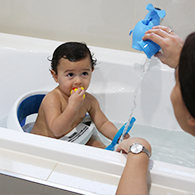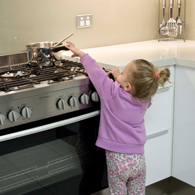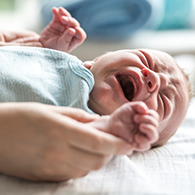Window safety
Children are admitted to hospital each year, with serious injuries, as a result of falling from a window or balcony. These falls often happen in the child's own home, over the warmer months when families leave windows and doors to balconies, open both during the day and at night.
Children aged from one to five years are most at risk, as they are naturally curious, but lack the ability to recognise danger.
How are children injured?
Falls
- Children may fall out of windows if they are able to climb on furniture to reach the window, or if they are jumping or playing on a bed near an open window.
- Injuries resulting from children falling from windows range from cuts and bruises to head injuries, broken limbs and even death.
How common are these injuries?
On average, each year 10 children are admitted to The Children’s Hospital at Westmead (CHW) after falling from a window. Almost all of these children fall from a window in their own home.
Of the children who have presented to CHW:
- 80% had significant or severe injuries;
- 80% had fallen more than two metres;
- 3 out of 5 cases admitted to hospital were boys;
- 80% were under 5 years of age;
- 50% of these falls involved furniture near the window.
Children can fall out of a window which is open more than 12.5cm, even if a fly screen is present.
Are there legal requirements to prevent window falls?
New buildings in Australia
Since 1 May 2013, The National Construction Code (NCC) has stated that any openable bedroom window in new residential buildings, with a fall of two metres or more to the surface below (measured from floor level), require protection to prevent children falling through them. This also applies to child care centres.
The NCC states, that where a person, including a child, could fall through an openable window located more than two metres above a surface below, a balustrade or barrier must be constructed. The barrier or balustrade, which may be constructed as the wall beneath the window sill, or a fixed window pane, among other solutions, must be constructed with a height of not less than 86.5cm above the floor beneath the window. The code also states that any opening in the barrier must not allow a 12.5cm sphere (round ball) to pass through it.
A flow chart describing which windows this applies to, is available at Australian Glass & Window Association
Strata buildings in NSW
By 13 March 2018, windows that have a fall of two metres or more to the surface below (measured from floor level) in strata buildings, had to have safety devices fitted to allow window openings to be locked at a maximum opening of 12.5cm.
The Strata Schemes Management Regulation 2016 (NSW), states that all strata buildings in NSW must be fitted with devices that enable their windows to be locked at less than or equal to 12.5cm when the devices are in use. This law applies to openable windows that have sills less than 1.7m above the inside floor and which are more than 2m above the floor level outside. Devices must be able to withstand an outward force of 250N.
Owner’s corporations must have devices installed on all windows above the ground floor.
Further information is available from NSW Fair Trading | Tenants and Home Owners.
Remember:
- Beds and other furniture should be kept away from windows, so that children cannot climb up to windows.
- Children should be taught to play away from windows.
- Where possible, open windows from the top.
- Do not rely on flyscreens to prevent a child from falling out of a window. Falls Prevention Warning labels are available for purchase via the Australian Glass & Window Association
- All windows, where the floor level below the window is 2m above ground level, should have window locks/latches fitted to stop them opening more than 12.5cm, or guards should be installed to protect the opening.
- Children should always be supervised.







